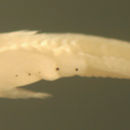fr
noms dans le fil d’Ariane


Description: Body shape ranges from thin, long and narrow in earlier-stage larvae to thicker with a large head, medium-sized eye and a terminal large wide mouth. Pectoral fins short, reaching about halfway to the vent. Pelvic fins without a pelvic frenum and can be fused or halfway fused, and short, extending clearly less than halfway to the vent, 4-5 procurrent caudal-fin rays. Dorsal and anal-fin bases relatively short, caudal peduncle short and narrowing. The caudal fin is short, wide and rounded. Lightly marked along the lower body: melanophores along the ventral midline sometimes at the isthmus, then just forward of the pelvic-fin insertion, followed by from one to seven additional melanophores along the abdominal midline always ending with a melanophore just forward of the vent. There are no melanophores along the anal-fin base. There is a prominent large, often dendritic, melanophore on the ventral caudal peduncle midline just behind the last anal-fin ray. Melanophores occur internally along the dorsal surface of the swim bladder and around the gut near the vent (no melanophores at the sacculus). Series of transitional larvae show development of the eye from a somewhat narrowed vertical oval to round (in most specimens the eye is round). Transitional larvae develop a dark stripe through the eye back to the operculum, melanophores on the lower jaw, scattered around and within the thorax, and in a stripe along the sides of the abdominal wall to the vent and continuing along the base of the anal fin and caudal peduncle to curve around the base of the lower and central caudal-fin rays. There is a conspicuous speckling of leukophores (and an absence of any melanophores) over the top of the head and extending along the dorsum of the body onto the caudal fin. Some individuals have a bubblewrap-like appearance to the skin.
Analogues: (post-anal fin solitary melanophore, small: <7 mm SL)
Diagnosis: Modal fin-ray counts of D-VII,11 A-10 and Pect 15 and partially-divided pelvic fins indicate Gobulus myersi and barely overlaps the range of some Psilotris species These genera have one fewer anal-fin ray (sometimes two) than second-dorsal-fin rays. Pelvic fins can be fused or halfway-fused in these larvae. The short pectoral fins and pelvic fins without a frenum, rounded caudal fin, broad head and stocky body of this larval type fits with Gobulus myersi (or Psilotris) rather than the other gobies with these fin-ray counts and fully-fused pelvic fins (i.e. some Gobiosoma and Elacatinus). The fin-ray count of this larval type borders the range but does not match Psilotris (too high for P. alepis; modal pectoral-fin rays too low for P. boehlkei and P. celsa). Confirming the identification as G. myersi is the white spotting on the upper half of the body from the top of the head to the caudal fin in transitional larvae: this species is unusual in being bicolored with light above and dark below (the common name is paleback goby). Gobulus is a genus with only four species; this one representative in the Atlantic and three endemic to the eastern Pacific region. Although this Atlantic species is reported to have fused pelvic fins (without a frenum) as adults, two of the Pacific Gobulus species have partially-fused pelvic fins (without a frenum), as do these larvae. fin-ray counts in this larval type often vary from the mode: second-dorsal-fin elements are often 10 or 12, anal-fin elements are often 9 or 11 and pectoral-fin-ray counts are often 14 or 16. (Chriolepis can share the median-fin ray count but should have more pectoral-fin rays, longer and separate pelvic fins, and a larger eye). (PE) G8a